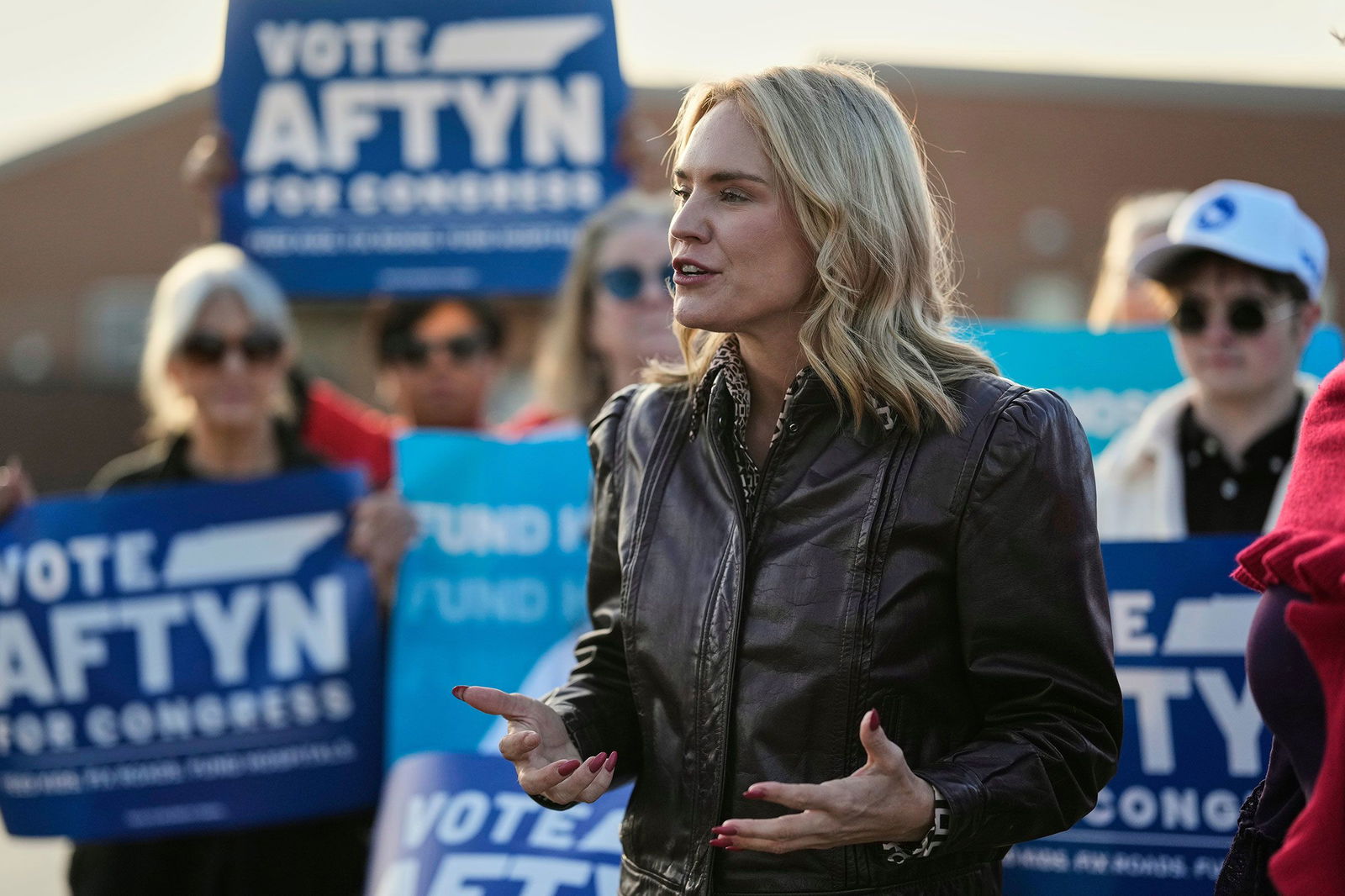Tennessee special election puts Democratic momentum in 2025 races to the test

Voters arrive to vote at a polling station in San Francisco
By Edward Wu, Kathryn Squyres, CNN
(CNN) — Democrats started this year in the doldrums, having lost both the White House and control of Congress and with their party heading toward record-low approval ratings.
They’re in a position to end it riding a wave of momentum, with one more chance to over-perform expectations and make the Republican majority in the US House even narrower.
Tennessee’s 7th Congressional District on Tuesday will host the fifth and final special US House election of the year. In the first four, Democrats exceeded the Democratic candidates’ margins in 2024 House races by an average of 16 points. They ran well ahead of Democrat Kamala Harris’ margins against President Donald Trump in New Jersey and Virginia’s off-year elections, with remarkably high turnout throughout the year.
Republican Mark Green, who resigned from the Tennessee 7th this year, won in 2024 by just over 20 points. Data on early voters suggests a more favorable environment compared with last year for Democratic candidate Aftyn Behn, who is running against Republican Matt Van Epps.
A deep-red district stretching west from Nashville would normally be an unlikely Democratic pickup opportunity. But national Democrats and Republicans are closely watching the Tennessee 7th anyway, with outside groups pouring money into the race and GOP-aligned groups sounding the alarm about Tuesday’s election.
The Democrat hits the national affordability message
Behn has focused her campaign on affordability, railing against the GOP spending bills and Trump’s tariffs. She pointed to Democrats’ success campaigning on this message in New York City, New Jersey and Virginia.
“I think these voters are looking around and life isn’t better,” Behn told CNN. “I think people are saying ‘we’ve had enough, we’re fed up.’”
Behn said the national attention to her race is welcome, especially because the South has “been underinvested and overlooked” and Tennessee historically has low voter turnout.
“Our theory of change was always like we have to ensure that every Democrat in the country cares about this race and sees the opportunity here to invest in the state of Tennessee,” she said.
Since winning a crowded primary in October, Van Epps has highlighted his background as a military helicopter pilot and focusing on lowering costs. In one campaign ad, he describes himself as on a “new mission to bring down prices, create good paying jobs, and lower healthcare costs for working families.”
Van Epps’ campaign declined an interview request.
“With strong conservative turnout, we will have a win next Tuesday, and I’ll hit the ground running, working with President Trump to lower the cost of living for hardworking Tennessee families,” he said in a statement.
Just last week, the Democratic-aligned House Majority PAC pledged $1 million to support Behn, the super PAC’s first spending on a special election this year. Groups aligned with Trump’s political operation and House Republicans’ campaign arm have spent money on Van Epps’ behalf.
Party leaders including Democratic National Committee Chair Ken Martin and former Vice President Kamala Harris have also made appearances in the district to support Behn, and progressive Rep. Jasmine Crockett of Texas video called in to rally supporters at an event with Behn.
Behn told CNN that Tennessee’s special election is another chance to send a national message.
“If we get with a certain number of points or if we flip it, that it will signal to Washington Republicans that this agenda that they’ve been running on is not welcomed and is not favorable by most voters, especially in deep-red territory,” Behn said.
While special election turnout tends to fall well short of midterm turnout, turnout this year has been relatively high. The four special elections for US House averaged 57% of 2022 midterm turnout in the same districts, higher than the 42% average for special elections between the 2022 midterms and 2024 presidential election.
The national attention seems to be driving fairly strong turnout in Tennessee so far: Through Monday, there were over 63,000 ballots cast early in-person or by mail (about 35% of 2022’s total turnout in the district). About two-thirds of ballots were cast pre-election in 2024, and a little over half were cast pre-election in the special primary, according to data from L2.
Strong Democratic signs despite the party’s national unpopularity
A strong performance on Tuesday by Behn would add to the growing evidence of a Democratic advantage in voter motivation.
In CNN’s October poll, just 29% of Americans said they had a favorable view of the Democratic Party and 55% had an unfavorable view, numerically the highest unfavorable rating in CNN’s polling going back over 30 years. Over a quarter of registered voters who are Democrats or Democratic-leaning said they have an unfavorable view of the party, up from 13% a year ago.
Despite this lagging popularity, deep dissatisfaction with Trump appears to have engaged Democratic voters. More registered Democrats now say they’re extremely motivated to vote than ahead of the 2024 presidential elections.
Looking ahead to 2026, Democratic-aligned voters overwhelmingly said their votes for Congress would be about Trump: 79% said their vote would be to send a message that they oppose Trump, compared to just 20% who say their vote would not be about Trump. Democratic-aligned voters who said their vote would be to oppose Trump were also more likely to say that they are extremely motivated to vote next year.
Extremely motivated voters overall said they preferred Democratic over Republican candidates by a wide margin, 59% to 37%, while less motivated voters preferred Republican candidates 48% to 34%.
What conclusions can we draw so far from this year?
Since the start of Trump’s first term, Democrats have regularly over-performed in special elections as higher propensity voters – particularly those with higher education levels – have gravitated towards Democratic candidates. In that time, Democrats have outpaced prior Democratic margins more often than not.
Drawing conclusions from special elections can be challenging – special elections are relatively infrequent and often have low turnout, which can result in large swings from higher turnout elections. Presidential and House results may diverge within a congressional district, so a candidate’s relative performance may appear to vary depending on which baseline is used for comparison.
Still, Democratic results in this year’s special elections have been particularly strong, more closely resembling the special elections early in Trump’s first term and stronger than those that occurred during the Biden presidency.
The average Democratic over-performance of 16 points is in the line with results from the first year of Trump’s first term, when Democrats beat their 2016 House margins by an average of 17 points.
Democrats have had higher turnout levels in other statewide races this year as well.
In April, more than 2.3 million voters turned out in a Supreme Court election in Wisconsin, nearly 90% of the votes cast in the state’s 2022 Senate race. Democratic-backed Judge Susan Crawford beat Harris’ 2024 margin in the state by nearly 11 points.
This trend continued earlier this month in the gubernatorial elections in New Jersey and Virginia and the special election for a Democratic-backed ballot measure in California.
Over 3.3 million votes were cast in New Jersey and 3.4 million votes in Virginia, both slightly higher than the number of votes cast in each state’s 2018 Senate race, the last time there was a statewide race in a midterm year in the two states. Turnout as a percentage of registered voters slightly trailed the 2018 turnout in both contests (50% in New Jersey and 54% in Virginia, compared to 53% and 59% in 2018). Democrats Mikie Sherrill and Abigail Spanberger outpaced Harris by over 8 points in New Jersey and over 9 points in Virginia.
In California, a Democratic-backed ballot measure passed by a margin of 29 points, almost 9 points ahead of Harris’ margin in the state. Over 11.5 million voters turned out in the race, more than the 10.9 million voters in the 2022 gubernatorial election but slightly behind the nearly 12.5 million votes in the 2018 race.
The-CNN-Wire
™ & © 2025 Cable News Network, Inc., a Warner Bros. Discovery Company. All rights reserved.
CNN’s Arit John contributed to this report.



